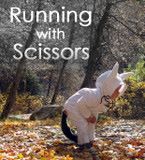Today we welcome Melissa from The Polka Dot Chair. She shares with us her tips for when your sewing project is not going smoothly.
On my blog I am frequently asked questions about how to sew, most are pretty specific and I answer them the best that I can, and some are more general, like "how do you learn to sew?", "where do I start?" and "what did I do wrong?" I think anyone that has ever sewn has felt the frustration of a project that is not going the way you envisioned it. I've been sewing since I was 15 and I can say that this has happened to me many many times. My husband has walked into my sewing room several times with a "why are you even doing this?" look on his face, and sometimes I agree with him (after resisting the urge to throw my sewing machine out the window *wink*) So I thought for my Sewing 101 contribution today I 'd share with you some of the "tips & tricks" that I have discovered in my years of sewing. The little things that I think help you get a finished project that you are proud of.
Number 1-Ask for help Most everyone who is sewing now had some help at the beginning of their sewing career. Maybe you have a friend who is an excellent seamstress, or a Grandmother who would love to share some of her knowledge with you, odds are that you know someone who can help you learn. Don't just ask "will you teach me to sew", that is too broad a statement and may ruffle a few feathers of the person you are asking... say something like "I started sewing this purse and got a pretty good start but now I'm at a point that I am stuck and was wondering if you could help me out a bit?" If you want to learn at some point there will be some "trial & error" and the only way to get past it is just to TRY, you are capable of doing a lot more than you think you are!! Give it a shot on your own then when you get stuck, turn to your friend to get some help. You can also try bribing them with something like "If I make a yummy lunch this week can you come over for a bit and help me with a project I'm working on?"... Most seamstress I know are easily bribed with food!

It may seem like a pain to get up from your sewing machine and go over to your ironing board to iron each seam you sew, but you MUST do it!! There is no better tip that I can give you than to IRON! I can always tell a project that was poorly pressed along the way. Invest in a good quality iron, next to your sewing machine this will be the most valuable tool in your sewing arsenal!
Number 3- Take a class! Even though I learned to sew as a teenager I still took sewing classes as an Adult. I can not tell you how much this has helped me. The teachers always helped me to look at things in new ways. I learned techniques that I never would have figured out on my own, plus there is the added bonus that you FINISH the project durning the class, so it doesn't get thrown in the "someday" pile. Most cities have either heirloom sewing or quilting stores that offer classes, talk a friend into going with you and be BRAVE and just sign up!
Number 4- Walk away... If you get to the point in a project where you are sewing sloppily or find yourself saying "good enough" more than a few times... walk away... Put it down and go do something else. This is the thing that took me the longest to figure out. I can not tell you how many times I have woken up in the morning and had a "uggggg" moment because I stayed up too late working on something that I was really not in the "mood" to be working on. If you get frustrated with a project or lose interest, it's OKAY to leave it for a bit. Nine times out of ten you will get your "mojo" back soon and be able to finish it up. There is nothing worse that working while your frustrated! So don't do it!!
Number 5- Just unpick it... I know no one ever likes to unpick something they have just sewn... but just do it. If it's not right, you will expend more energy trying to fix it later than just unpicking it in the first place.
Number 6- Change your Needle Once in a class I took the instructor informed us that we should change our needle every-time we start a new project. I don't change mine that often but try to change it every few projects. A lot of times a dull needle will cause your machine to skip stitches, pull fabric or cause problems with your tension. So ask yourself "when was the last time you changed your needle?"... Probably been a while...
Number 7- Rethread your Machine Just think of it like rebooting your computer, one little thing can fix a multitude of ills. If you break a needle, break your thread, or your machine starts sewing funny, rethread it. Trust me it works :)
Wonderful advice, Melissa. My seam ripper and I have too cozy of a relationship! Check out Melissa's blog and the fabulous projects she shares like this adorable baby dress and quilt or her Thanksgiving countdown calendar.



















































